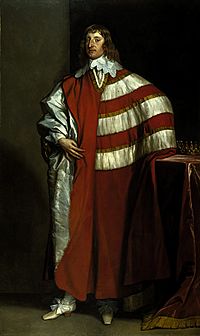Charles Seton, 2nd Earl of Dunfermline facts for kids
Charles Seton, 2nd Earl of Dunfermline (born November 1615 – died 11 May 1672) was a Scottish nobleman. He was known as Lord Fyvie until his father passed away in 1622. Charles Seton was also a member of the Privy Council of Scotland, a group of trusted advisors to the King.
Contents
Early Life and Family
Charles Seton was the son of Alexander Seton, 1st Earl of Dunfermline. His mother was Margaret, whose father was James Hay, the 7th Lord Hay of Yester. This meant Charles came from a very important family in Scotland.
Role During the Civil War
During the English Civil War, Charles Seton was a strong supporter of the King. People who supported the King were called Royalists. When King Charles I was executed in 1649, Charles Seton had to leave Scotland for safety.
However, he returned to Scotland the very next year. This was when King Charles II came back to try and reclaim his throne.
Later Life and Important Roles
From 1661 until his death in 1672, Charles Seton held an important job. He was the Keeper of the Privy Seal of Scotland. This person was in charge of the King's special seal. This seal was used to make official documents legal.
Marriage and Connections
Lord Dunfermline was married to Mary Douglas. Her father was William Douglas, 7th Earl of Morton. Mary Douglas became good friends with a woman named Anne Halkett in 1650.
Mary even introduced Anne Halkett to King Charles II at Dunfermline Palace. Mary and Anne also traveled together to several famous Scottish castles. These included Glamis, Brechin, and Fyvie Castle.
End of the Title
Charles Seton passed away in 1672. His two sons then became the Earls of Dunfermline. First, his son Alexander Seton, 3rd Earl of Dunfermline took the title. Alexander lived from 1642 to 1677.
After Alexander's death, his brother James Seton, 4th Earl of Dunfermline became the Earl. James passed away in 1694. Neither of Charles's sons had children. Because of this, the title of Earl of Dunfermline ended when James was declared an outlaw in 1690.


